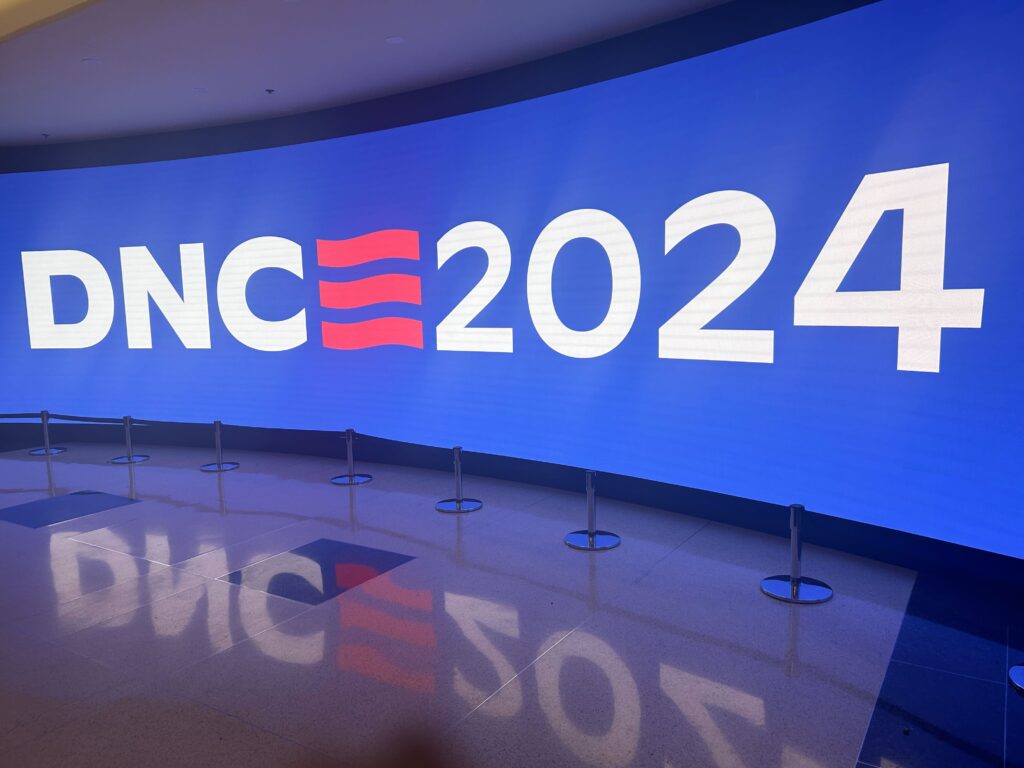The Oregon Democratic Party sent more than 70 delegates to the Democratic National Convention in Chicago. (Ariana Figueroa/States Newsroom)
The last month of American politics has been a whirlwind, but the Democratic National Convention in Chicago has brought a monumental shift in electoral politics.
The palpable shift from burdened to joy within the Democratic Party followed the historic decision by President Joe Biden to drop out of the 2024 campaign and endorse the first Black woman and the first person of South Asian descent to replace him on the party’s ticket.
This decision prompted an immediate backlash from the Republican nominee, who was keen to run a campaign against a failing octogenarian, so confident after the horrendous debate that his campaign was touting the real possibility of turning traditionally blue states red.
The conversation turned quickly to Vice President Kamala Harris’s racial composition, which as a biracial woman born and raised in Oklahoma, triggered latent feelings of not belonging when I was younger or being unqualified for opportunities that were presented to me as an adult academic.
A family member recently confided in me that she believed that Harris “just had not done enough” to be president, a sentiment that has been promulgated in certain circles and on particular media outlets that smacks as a distinct way of saying that because of who she happens to be, the resume that to any person using the veil of ignorance would more than qualify a being to ascend to the highest office in the land, is null and void.
The questioning of a multi-racial person’s identity and ethnic “authenticity” should never be a topic of debate on a national stage, particularly when that debate and questioning is being conducted by a group of homogeneous looking men.
The ethnic composition of the United States is diverse and becoming more so every day.
As of 2021, the largest racial or ethnic group in the United States was “white alone non-Hispanic population” at almost 58% of the population, but that number decreased from 63.7% in 2010. Hispanic/Latinos account for 19% of the population while Black Americans account for 12%. Roughly, 4% of the American population identifies as multiracial, meaning that the United States today is a more diverse and politically complicated nation than in even the immediate past.
This diversity was on full display at the Democratic National Convention in Chicago.
As a millennial woman of color who has studied global politics for two decades, I have been gobsmacked by the targeted deployment of popular culture to draw in a notoriously underrepresented and undercourted segment of the electorate, the youth, particularly, youth of color.
What those of us who have been paying attention have witnessed at the DNC is a complete shift in American electoral politics going forward: the Harris-Walz campaign is not a Boomer-run, Boomer-targeted campaign. For the first time in my lifetime, we are seeing a genuine generational shift to Millennial-run campaigns that are speaking directly to the two younger generations of the electorate: Millennials and Generation Z.
These two generations now account for a majority of the voting population in the United States, and it is well past time that the two major political parties start appealing to us in a meaningful way.
Pew Research Center reports as of July 2019, the Millennials, folks born between 1981 and 1996 totaled 72.1 million, or 21.7% of the population. The total Boomer population is 71.6 million people or 20.3% of the population. As for Generation Z, around 24 million in the cohort became eligible to vote in the 2020 election, and even in 2018, the youngest generation was making electoral waves. In the 2018 midterm elections, Generation X, the Millennials, and Generation Z cast 62.2 million votes to the 60.1 million votes cast by the Boomer and older generations.
What we have seen from one political party is a recognition that a fresh infusion of not only leaders, but purpose and “vibe” was necessary.
What makes me think this shift occurred? You do not get a DJ’d roll call vote with each state adopting a theme song that features an artist from that state without a Millennial being involved. Oklahoma’s delegation was announced to a Garth Brooks’ song. Atlanta rapper Lil Jon performed before Georgia’s delegation pledged their votes. And we heard the pointed and targeted use of Snoop Dogg, Tupac, and the most played Kendrick Lamar song of 2024 on the floor of the Democratic National Convention.
The convention was a turning point for future campaigns, by making it impossible for candidates and political parties in future elections to go back to Boomer-style, kiss the baby, rally in a jet hangar politics.
The Democratic Party has tapped into the current consciousness of America and exploited a need for fun, happiness, joy, pleasure and to dance like no one is watching — or like everyone is if you are on national television.
It is a sentiment and a vibe that plays with certain segments of the American population, but as I mentioned at the start of this article, this is not your granddaddy’s campaign.

